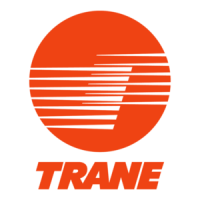
Do you have a question about the Trane TUH1D120A9601A and is the answer not in the manual?
| Model | TUH1D120A9601A |
|---|---|
| Efficiency Rating | 96% AFUE |
| Fuel Type | Natural Gas |
| Voltage | 120V |
| Type | Upflow |
| Heating Capacity | 120, 000 BTU/hr |
| Blower Motor | Multi-Speed |
| Furnace Type | Gas Furnace |
| Vent Diameter | 4 inches |
Instructions covering vent system installation, material requirements, and gas piping according to codes.
Steps for preliminary inspections, lighting, sequence of operation, and control adjustments.
Warning regarding propane gas heavier than air and the recommendation for gas detecting devices.
Specifies minimum clearances to combustible materials for various furnace orientations and locations.
Details on ensuring adequate airflow for combustion and ventilation to maintain furnace efficiency and safety.
Explains furnace venting types (Direct Vent, Nondirect Vent) and general system requirements.
Reinforces the critical need for proper venting to prevent carbon monoxide poisoning or death.
Table showing maximum equivalent vent and inlet air pipe lengths for upflow/horizontal installations.
Table showing maximum equivalent vent and inlet air pipe lengths for downflow/horizontal installations.
Table specifying required clearances for direct vent terminal installations in Canada and the US.
Table specifying required clearances for non-direct vent terminal installations in Canada and the US.
Mandatory requirements for installing carbon monoxide detectors for side wall vented appliances.
Notes on drain piping, manifolding, and preventing freeze-up of the condensate drain line.
Wiring diagram for a single-stage furnace with a heating/cooling thermostat, including notes.
Details on gas piping installation, including shut-off valves, drip legs, and pressure testing.
Safety warnings for gas piping installation, including leak checks and avoiding open flames.
Procedure for adjusting manifold pressure using a manometer and checking for leaks.
Guidance on reducing furnace input ratings for installations above 2,000 ft. and changing orifices.
Describes the step-by-step process of furnace operation from thermostat call to shutdown.
Procedure for checking limit switches and other safety devices for proper operation.
Guidance on adjusting airflow and blower motor speed for optimal performance.
Lists common abnormal conditions such as vent blockage, loss of flame, and blower failure.
Explains causes for system lockout and the procedure to reset the furnace after an event.












